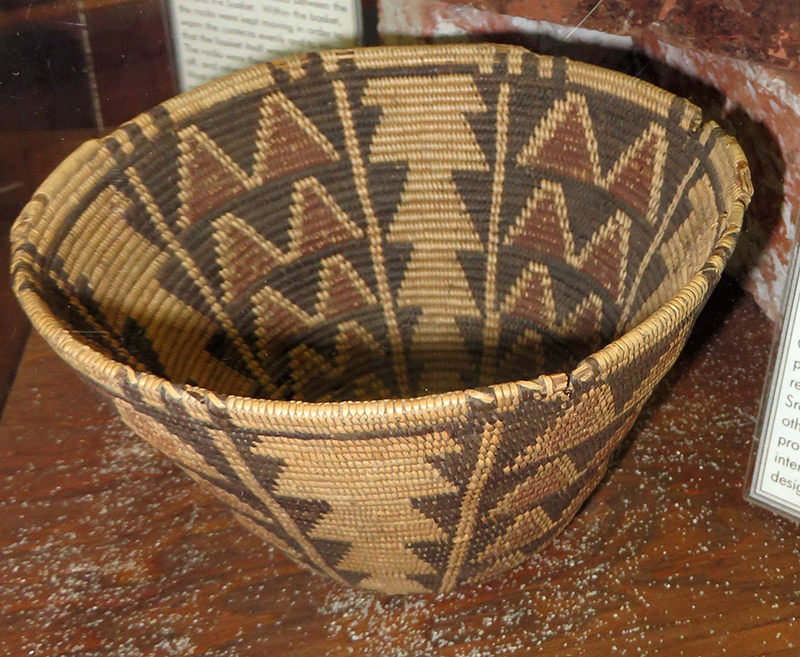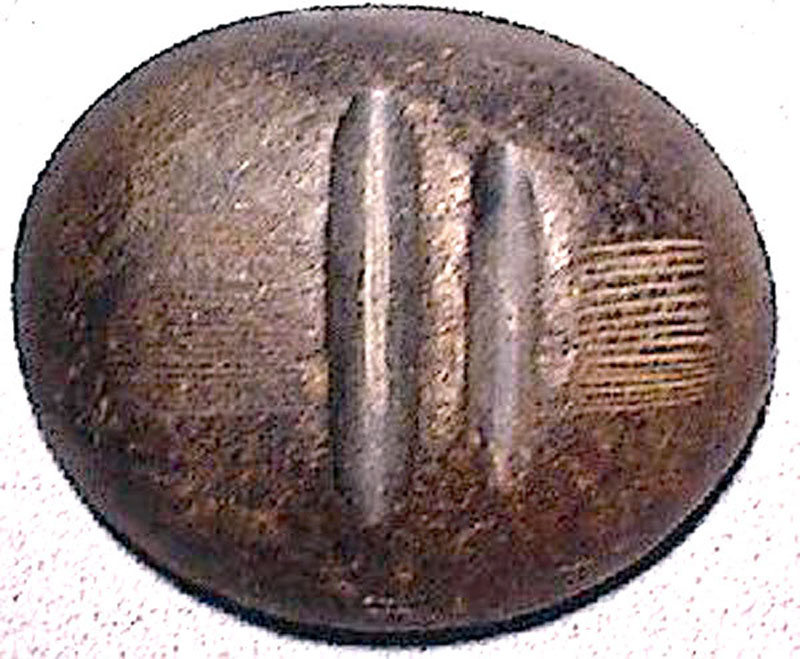|
|
Ramona Museum, San Gabriel

Click image to enlarge
June 14, 2015 — One of two California Indian coiled baskets on display at the Ramona Museum, 339 S. Mission Drive, San Gabriel. Probably yucca root (red) and bracken fern (black) designs on a sedge root background. Kern River: Either Yokuts on the west (Tejon area) or Tubatulabal on the east (Lake Isabella area). Kitanemuk is also a possibility. According to the museum signage, this basket "was purchased in 1875 from a native resident of a village near Tejon by Sra. Julian Ruiz de LeLong." When the Spanish mission period ended in the 1820s, many Native Americans from several different cultures — from San Gabriel to Santa Barbara, including the Santa Clarita Valley — relocated to the Tejon area, where in 1853 the San Sebastian Indian Reservation was established. After the reservation was formally disbanded in 1864, many remained in the area. Women (almost exclusively women) made baskets both for their own use and for sale to tourists. This basket may have been one such souvenir item.
The Ramona Museum houses the collection of Ramona Parlor 109, the L.A.-based chapter of Native Sons of the Golden West, a historical association of persons born in California (regardless of ancestry). The Ramona Museum's core collection was donated to Ramona Parlor 109 in 1912 by the organization's historian, Charles Prudhomme. Chartered in 1887, Ramona Parlor 109 performed the functions of a local historical society in the Santa Clarita Valley until the SCV established its own society in 1975.
LW2807c: 9600 dpi jpeg from digital photograph 6-14-2015 by Leon Worden. |
Bowers Cave Specimens (Mult.)
Bowers on Bowers Cave 1885
Stephen Bowers Bio
Bowers Cave: Perforated Stones (Henshaw 1887)
Bowers Cave: Van Valkenburgh 1952
• Bowers Cave Inventory (Elsasser & Heizer 1963)
Tony Newhall 1984
• Chiquita Landfill Expansion DEIR 2014: Bowers Cave Discussion
Vasquez Rock Art x8
Ethnobotany of Vasquez, Placerita (Brewer 2014)
Bowl x5
Basketry Fragment
Blum Ranch (Mult.)
Little Rock Creek
Grinding Stone, Chaguayanga
Fish Canyon Bedrock Mortars & Cupules x3
2 Steatite Bowls, Hydraulic Research 1968
Steatite Cup, 1970 Elderberry Canyon Dig x5
Ceremonial Bar, 1970 Elderberry Canyon Dig x4
Projectile Points (4), 1970 Elderberry Canyon Dig
Paradise Ranch Earth Oven
Twined Water Bottle x14
Twined Basketry Fragment
Grinding Stones, Camulos
Arrow Straightener
Pestle
Basketry x2
Coiled Basket 1875
Riverpark, aka River Village (Mult.)
Riverpark Artifact Conveyance
Tesoro (San Francisquito) Bedrock Mortar
Mojave Desert: Burham Canyon Pictographs
Leona Valley Site (Disturbed 2001)
2 Baskets
So. Cal. Basket
Biface, Haskell Canyon
2 Mortars, 2 Pestles, Bouquet Canyon
|
The site owner makes no assertions as to ownership of any original copyrights to digitized images. However, these images are intended for Personal or Research use only. Any other kind of use, including but not limited to commercial or scholarly publication in any medium or format, public exhibition, or use online or in a web site, may be subject to additional restrictions including but not limited to the copyrights held by parties other than the site owner. USERS ARE SOLELY RESPONSIBLE for determining the existence of such rights and for obtaining any permissions and/or paying associated fees necessary for the proposed use.





































